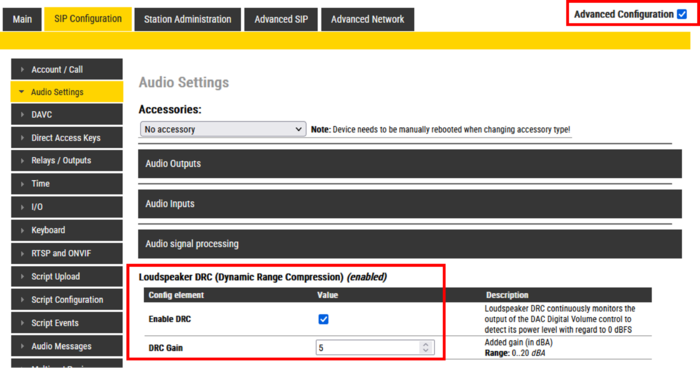Difference between revisions of "Dynamic Range Compression (DRC)"
From Zenitel Wiki
(→Configuring the DRC feature) |
|||
| Line 8: | Line 8: | ||
* ''The DRC is a dynamic digital signal gain adjustment function, and some signal clipping may occur if the DRC is configured to use high gain''. | * ''The DRC is a dynamic digital signal gain adjustment function, and some signal clipping may occur if the DRC is configured to use high gain''. | ||
* ''The DRC function works very well in combination with the [[Automatic Volume Control (AVC)]]''.}} | * ''The DRC function works very well in combination with the [[Automatic Volume Control (AVC)]]''.}} | ||
| − | + | ||
| + | |||
== Configuring the DRC feature== | == Configuring the DRC feature== | ||
Configuration is done from the Audio Settings menu. First enable '''Advanced Configuration''' mode. Depending on the mode of operations, select: | Configuration is done from the Audio Settings menu. First enable '''Advanced Configuration''' mode. Depending on the mode of operations, select: | ||
Revision as of 16:02, 23 October 2023
Dynamic Range Compression (DRC) is a feature in the Zenitel IP devices. The DRC function is processing the audio signal, and helps even out the loud and quiet parts. Lower signals will get gain applied, but not more than there is headroom for up to digital full scale.
For intercom devices and IP Speakers the DRC will normally have a good effect on regular speech signals, and will often increase the loudspeaker output noticeably. For already maximized signals, such as prerecorded alarm tones, DRC will have little or no effect.

|
|
Configuring the DRC feature
Configuration is done from the Audio Settings menu. First enable Advanced Configuration mode. Depending on the mode of operations, select:
- Edge mode: Edge Configuration > Audio Settings > Audio signal processing
- SIP mode: SIP Configuration > Audio Settings > Audio signal processing
- ICX-AlphaCom mode: Advanced ICX-AlphaCom > Audio Settings > Audio signal processing
 |
| Dynamic Range Compression configuration menu (firmware 7 and later) |
- Enable AEC: Check the box to enable suppression of echo on the microphone signal. Default enabled. If disabled the loudspeaker and microphone will be open without any audio processing.
- AEC mode: Sets the aggressiveness of the echo suppressor. A higher level trades off double-talk performance for increased echo suppression. Available suppression levels:
- Low
- Moderate
- High
- Half Duplex
With "Half Duplex" the loudspeaker will be muted when speaking into the microphone.
High or Half Duplex can be used in noisy or acoustic challenging environments, or in customized stations without optimal acoustic design, where one is experiencing issues with echo, chopping audio or one-way audio.

|
|

